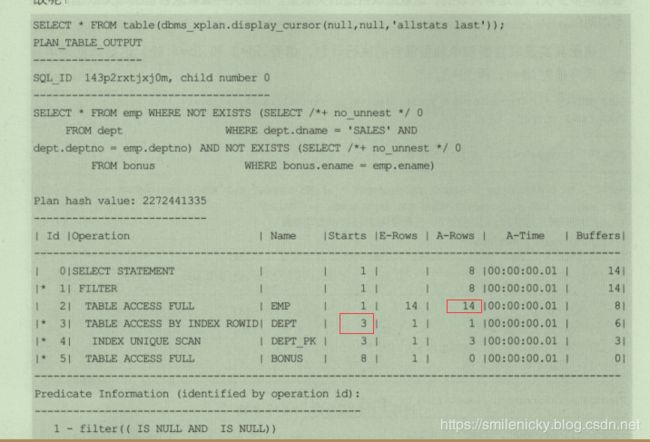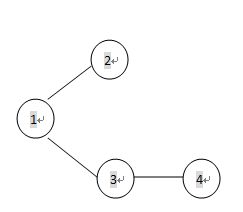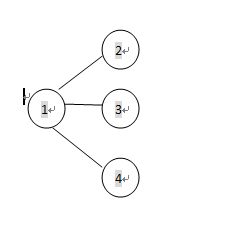Orace SQL调优系列之执行计划学习笔记
文章目录
- 一、获取执行计划的方法
- (1) explain plan for
- (2) set autotrace on
- (3) statistics_level=all
- (4) dbms_xplan.display_cursor获取
- (5) 事件10046 trace跟踪
- (6) awrsqrpt.sql
- 二、解释经典执行计划的方法
- 【单独型】
- 【联合型关联型】
- (1) 联合型的关联型(NL)
- (2) 联合型的关联型(FILTER)
- (3) 联合型的关联型(UPDATE)
- (4) 联合型的关联型(CONNECT BY WITH FILTERING)
- 【联合型非关联型】
最近拜读《收获,不止SQL优化》一书,并做了笔记,方便自己以后回顾,同时放在网上或许也有益于别人
一、获取执行计划的方法
(1) explain plan for
步骤:
- 1:explain plan for 你的SQL;
- 2:select * from table (dbms_xplan. display()) ;
- 优点:不需要真的执行,快捷方便
- 缺点:没有输出运行时的统计信息(逻辑读、递归调用,物理读),因为没有真正执行,所以不能看到执行了多少行、表被访问了多少次等等
(2) set autotrace on
sqlplus登录:
用户名/密码@主机名称:1521/数据库名
步骤:
- 1:set sutoatrace on
- 2:在此次执行你的sql;
- 优点:可以看到运行时的统计信息(逻辑读、递归调用,物理读)
- 缺点:不能看到表被访问了多少次,也需要等sql执行完成才能看
(3) statistics_level=all
步骤:
- 1:alter session set statistics_level=all;
- 2:在此处执行你的SQL;
- 3:select * from table(dbms_xplan.display_cursor(null , null,‘allstats last’));
假如使用了Hint语法: /*+ gather_plan_statistics */,就可以省略步骤1,直接执行步骤2和3,获取执行计划
关键字解读:
- Starts:该SQL执行的次数
- E-Rows:为执行计划预计的行数
- A-Rows:实际返回的行数,E-Rows和A-Rows作比较,就可以看出具体那一步执行计划出问题了
- A-Time:每一步实际执行的时间,可以看出耗时的SQL
- Buffers:每一步实际执行的逻辑读或一致性读
- Reads:物理读
- OMem:当前操作完成所有内存工作区操作总使用私有内存工作区(PGA)的大小
- lMem:当工作区大小无法符满足操作需求的大小时,需要将部分数据写入临时磁盘空间中(如果仅需要写入一次就可以完成操作,就称一次通过,One-Pass;否则为多次通过,Multi-Pass)。改数据为语句最后一次执行中,单次写磁盘所需要的内存大小,这个是由优化器统计数据以及前一次执行的性能数据估算得出的
- Used-Mem:语句最后一次执行中,当前操作所使用的内存工作区大小,括号里面为(发生磁盘交换的次数,1次即为One-Pass,大于一次则为Mullti-Pass,如果没有使用磁盘,则显示为OPTI1MAL)
OMem、lMem为执行所需要的内存评估值,OMem为最优执行模式所需要内存的评估值,Used-Mem为消耗的内存
优点:
- 可以从STARTS得出表被访问多少次;
- 可以清晰地从E-ROWS和A-ROWS中分别得出预测的行数和真实的行数
缺点: - 必须等到语句真正执行完成后,才可以得出结果
- 无法控制记录打屏输出,不想aututrace有traceonly命令
- 没有专门的输出统计信息,看不到递归调用的次数,看不出物理读具体数值,不过有逻辑读,逻辑读才是重点
(4) dbms_xplan.display_cursor获取
步骤
从共享池获取
//${SQL_ID}参数可以从共享池拿
select * from table(dbms_xplan.display_cursor(${SQL_ID}));
还可以从AWR性能视图里获取
select * from table(dbms_xplan.display_awr(${SQL_ID}));
多个执行计划的情况,可以用类似方法查出
select * from table(dbms_xplan.display_cursor(${SQL_ID},0));
select * from table(dbms_xplan.display_cursor(${SQL_ID},1));
优点:
- 和explain一样不需要真正执行,知道sql_id就好
缺点:
- 不能判断处理了多少行
- 无法判断表被访问了多少次
- 没有输出运行时的相关统计信息(逻辑读、递归调用、物理读)
(5) 事件10046 trace跟踪
步骤:
1:alter session set events '10046 trace name context forever,level 12';//开启跟踪
2:执行你的语句
3:alter session set events '10046 trace name context off';//关闭跟踪
4:找到跟踪产生的文件
5:tkprof trc文件 目标文件 sys=no sort=prsela,exeela,fchela(格式化命令)
优点:
- 可以看出SQL语句对应的等待事件
- 可以列出sql语句中的函数调用的
- 可以看出解析事件和执行事件
- 可以跟踪整个程序包
- 可以看出处理的行数,产生的逻辑读
缺点: - 步骤比较繁琐
- 无法判断表被访问了多少次
- 执行计划中的谓词部分不能清晰地显示出来
(6) awrsqrpt.sql
步骤:
1:@?/rdbms/admin/awrsqrpt.sql
具体可以参考我之前的博客:https://smilenicky.blog.csdn.net/article/details/89429989
二、解释经典执行计划的方法
可以分为两种类型:单独型和联合型
联合型分为:关联的联合型和非关联的联合型
【单独型】
单独型比较好理解,执行顺序是按照id=1,id=2,id=3执行,由远及近
先scott登录,然后执行sql,例子来自《收获,不止SQL优化》一书
select deptno, count(*)
from emp
where job = 'CLERK'
and sal < 3000
group by deptno
【联合型关联型】
(1) 联合型的关联型(NL)
这里使用Hint的nl
select /*+ ordered use_nl(dept) index(dept) */ *
from emp, dept
where emp.deptno = dept.deptno
and emp.comm is null
and dept.dname != 'SALES'
这图来自《收获,不止SQL优化》,可以看出id为2的A-Rows实践返回行数为10,id为3的Starts为10,说明驱动表emp访问的结果集返回多少条记录,被驱动表就被访问多少次,这是关联型的显著特征

![]()
![]()
关联型不一定是驱动表返回多少条,被驱动表就被访问多少次的,注意FILTER模式也是关联型的
(2) 联合型的关联型(FILTER)
前面已经介绍了联合型关联型(nl)这种方法的,这种方法是驱动表返回多少条记录,被驱动表就被访问了多少次,不过这种情况对于FILTER模式下并不适用
执行SQL,这里使用Hint /*+ no_unnset */
select * from emp where not exists (select /*+ no_unnset */ 0 from dept
where dept.dname='SALES' and dept.deptno = emp.deptno) and not exists(select /*+ no_unnset */ 0 from bonus where bonus.ename = emp.ename)
ps:图来自《收获,不止SQL优化》一书,这里可以看出id为2的地方,A-Rows实际返回行数为8,而id为3的地方,Starts为3,说明对应SQL执行3次,也即dept被驱动表被访问了3次,这和刚才介绍的nl方式不同,为什么不同?
 查询一下SQL,可以看出实际返回3条,其它的都是重复多的,
查询一下SQL,可以看出实际返回3条,其它的都是重复多的,
select dname, count(*) from emp, dept where emp.deptno = dept.deptno group by dname;
所以,就很明显了,被过滤了重复数据,也就是说FILTER模式的对数据进行过滤,驱动表执行结果集返回多少行不重复数据,被驱动表就被访问多少次,FILTER模式可以说是对nl模式的改善
(3) 联合型的关联型(UPDATE)
update emp e1 set sal = (select avg(sal) from emp e2 where e2.deptno = e1.deptno),comm = (select avg(comm) from emp e3)
联合型的关联型(UPDATE)和FILTER模式类似,所以就不重复介绍
(4) 联合型的关联型(CONNECT BY WITH FILTERING)
select /*+ connect_by_filtering */ level, ename ,prior
ename as manager from emp start with mgr is null connect by prior empno = mgr
【联合型非关联型】
可以执行SQL
select ename from emp union all select dname from dept union all select '%' from dual
对于plsql可以使用工具查看执行计划,sqlplus客户端的可以使用statistics_level=all的方法获取执行计划,具体步骤
- 1:alter session set statistics_level=all;
- 2:在此处执行你的SQL;
- 3:select * from table(dbms_xplan.display_cursor(null , null,‘allstats last’));



